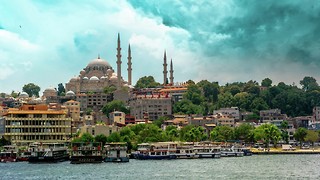Film: To The Wonder
Harry Jackson is impressed by the bravery of Terrence Malick’s new masterpiece.

To the Wonder, the sixth feature film by the enigmatic auteur Terrence Malick, begins by subverting all of the expectations that come with his work. We’re greeted not by the beautiful, lucid photography of Emmanuel Lubezki, but rather by the discoloured, chaotic output of a camera phone, wielded by Ben Affleck, capturing fleeting moments onboard a French train and around the streets of Paris. The rich images that characterise Malick’s cinema are soon restored, but he has already made the bold pronouncement: for the first time in his four-decade long career, his subject is the world we live in today – unstable, rootless, and torn apart by spiritual crisis.
Upon finding rapturous love in the heart of the Old World, namely (and importantly) in the Abbey of Mont Saint-Michel, Affleck and his European flame Olga Kurylenko return to Oklahoma with her ten-year old daughter. Something isn’t right. The ‘calm, honest, rich’ nation that Kurylenko finds upon her arrival begins to confuse her. Her daughter feels a numbing sense of dislocation and isolation. A Catholic priest, magnificently played by Javier Bardem, visits his impoverished parishioners, flees his duty, and doubts the faith he preaches with such conviction at the altar. Affleck and Kurylenko join together and drift apart as the film vaguely sketches the ups and downs of their relationship. During a separation, Affleck reunites with a former acquaintance played by Rachel McAdams, who features in a short but devastating passage as a woman unable to cope with loss.
Narrative has never been a major concern for Malick, and even his most satisfying film in this regard – his 1978 Texas Panhandle love triangle Days of Heaven – is hardly Magnificent Obsession when it comes to narrative pleasures. Critics who complain about the formlessness of To the Wonder’s plot, its failure to present rounded characters with fleshed out back-stories, or its failure to explain character motivation are clearly missing the point. Terrence Malick doesn’t direct drama any more. He is an artist plying his craft in the medium of pure cinema. Like Antonioni, whose Il deserto rosso echoes through this film, Malick expresses himself through image and sound. We learn more about McAdams’ character in a few ethereal and haunting moments, as she wanders the darkened house that contains her most painful memories, than we ever could from a million lines of expository dialogue.
Malick’s film is a study of the spiritual desolation of our age. The central characters endlessly seek one another and seek God, but are frustrated at every turn. By contrast, The Tree of Life reads as a mournful celebration of the world we have lost – a place where our doubts and conflicts are mediated by structures and certainty that we no longer have. It isn’t, by any means, an unremittingly grim film. The highs of Affleck and Kurylenko’s love are transcendent, and the conclusion provides some sense of uncertain hope. But these victories are exceptional, and merely serve to assert the power of human agency in a hostile world – a world in which even the water is poisoned, as one thread of this incredibly rich tapestry suggests.
The film clearly won’t be to everybody’s tastes, and its content may offend some. The deeply conservative and Christian source of Malick’s pessimism, and of his optimistic conclusion, will be foreign to many, and his emphasis on emotional commitment, marriage, and procreation will alienate the dogmatically liberal, but the fact remains that Malick has once again produced a stunning meditation on enormous and important issues. If you’re looking for a good yarn, some light entertainment, or an exciting trip to the movies, this is not the film for you. But if you’re willing to open yourself up to an experience unlike any you’ll find at the cinema today, count yourself lucky that you live in one of the few cities with a theatre willing to show this brave, towering masterpiece.
 News / Newnham postgrads referred to homeless charities as College runs out of rooms31 July 2025
News / Newnham postgrads referred to homeless charities as College runs out of rooms31 July 2025 Arts / William Morris’ little-known labours in Cambridge25 July 2025
Arts / William Morris’ little-known labours in Cambridge25 July 2025 Lifestyle / Break-ups in the bubble31 July 2025
Lifestyle / Break-ups in the bubble31 July 2025 News / Lucy Cav secures £47m loan to expand student accommodation30 July 2025
News / Lucy Cav secures £47m loan to expand student accommodation30 July 2025 Theatre / One year, many stages: the fresher actors behind Cambridge theatre31 July 2025
Theatre / One year, many stages: the fresher actors behind Cambridge theatre31 July 2025








